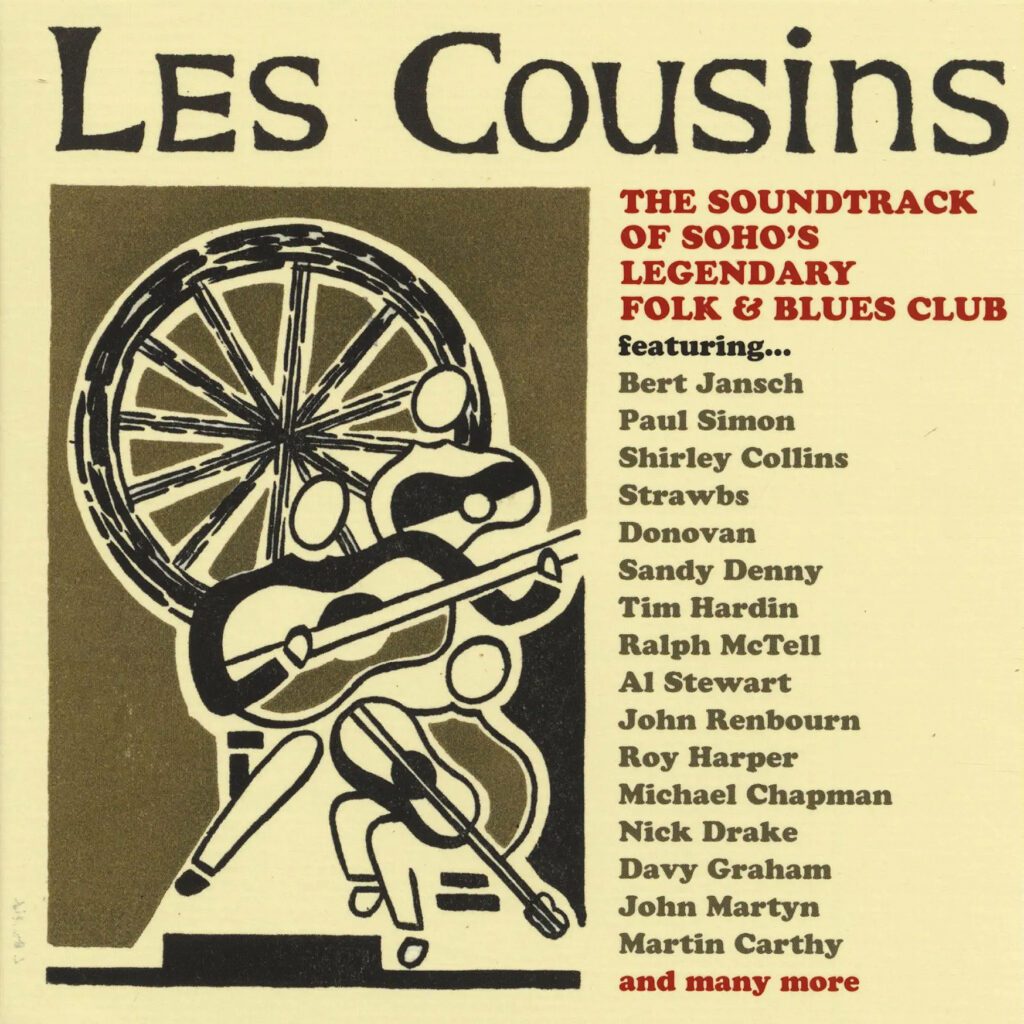“Let me take you by the hand/And lead you through the streets of London/I’ll show you something to make you change your mind” —“Streets of London” by Ralph McTell
The folk revival that began in the late ’50s and lasted almost into the early ’70s, is often most associated with New York’s Greenwich Village and Cambridge in Massachusetts while other American locales like Philadelphia and Chicago were also part of the scene. The folk revival, or “folk scare” as it was so humorously referred to by one of its key participants, Dave Van Ronk, was however, not just an American phenomenon. While America had a long roots music history, England also did and the folk revival there happened a little later and centered around a basement club in London’s Soho district called Les Cousins. Initially a French restaurant and then a discotheque, the folk club incarnation launched in April of 1965.
Like folk clubs in America, it served many purposes. It revived the songs and artists from folk’s past, which in some cases had been around for centuries. Folk was also a catch-all term that included blues, bluegrass, country, and other forms of roots music, even early forms of jazz, ragtime, and jug music. Maybe most importantly and foremost for many in England, it described an acoustic-based music played by artists who were song interpreters and stylists, and in some cases guitar wizards.
The list of musicians who actually played at the club in one form or another just hung out there, since its founding in 1965 and final year in 1972 is staggering. This comprehensive and widely varied, 72-track, 3-CD box set covering music released between 1963 and 1973 does not include any live performances from the club, but instead features some of the key figures of the British folk scene, American musicians who count Les Cousins as a key stepping stone in their music evolution and artists who may not have been strictly folk, but who are part of the club’s rich musical history.
It is interesting to note how many of the artists included here would go on to have major mainstream success by moving beyond folk to become rock, progressive, or singer-songwriter artists. Some of the big names included here who would go on to massive popularity include Paul Simon, Donovan, Cat Stevens, and Al Stewart, with songs from Simon, Donovan, Tim Hardin, and Tom Rush included here, the most well-known.
Artists who didn’t necessarily achieve popular stardom, but who became major artists of the English folk-rock movement and were associated at one point with Joe Boyd, include The Incredible String Band, Nick Drake, Sandy Denny, and Plainsong. Along with Denny and Iain Matthews of Plainsong, another person who would become a member of Fairport Convention, Dave Swarbrick, is also included here. Maddy Prior, Jacquie McShee, and Ralph McTell would also fit into the British folk-rock category.
Artists who were lauded for their acoustic guitar virtuosity and even in some cases songwriting and singing include Bert Jansch, John Renbourn, John Martyn, and two British legends who are maybe not as well-known in America: Davy Graham and Wizz Jones. British artists who would emerge out of the folk scene and become more well known as progressive artists include Kevin Ayres, Roy Harper, and The Strawbs. British blues legends such as Alexix Korner and Long John Baldry are included here as well.
Two artists who were major players on the ’60s folk scene but who never gained any widespread popularity are Brit Julie Felix and the legendary American cult figure Jackson C. Frank. Americans included here that were folk staples of the era who also continued on past the club’s heyday are Tim Hardin, Dave Van Ronk, Spider John Koerner, and Tom Rush, who is still active today.
Groups that included a healthy dose of British ’60s pop and even psychedelia are Dr. Strangely Strange and The Piccadilly Line. One of the most enduring aspects of the scene was how artists from many different styles, backgrounds and lineage were embraced and equally respected. Bridget St. John is one such artist. Her profile seems to grow through the years and may be due for a major revival.
The music here is timeless and has held up remarkably well over the years. While there are familiar songs here by Paul Simon, Donovan, Tom Rush, and Tim Hardin, for many the discovery of the lesser-known music here will make this box set such a rewarding experience.
Like previous releases from the Cherry Red music label group, it’s not only the music here that is so wonderful, but the presentation. The three CDs are housed in sleeves inside a sturdy clamshell box. There is also an invaluable 36-page booklet. It includes wonderful period photos, an essay and liner notes, and each track is annotated with a blurb, dates and label info. These booklets are almost worth the price of admission alone.
This is a must-have box set for fans of the great folk revival and considering the high price of lavish reissue packages these days, is a steal.
GRADED ON A CURVE:
B+
